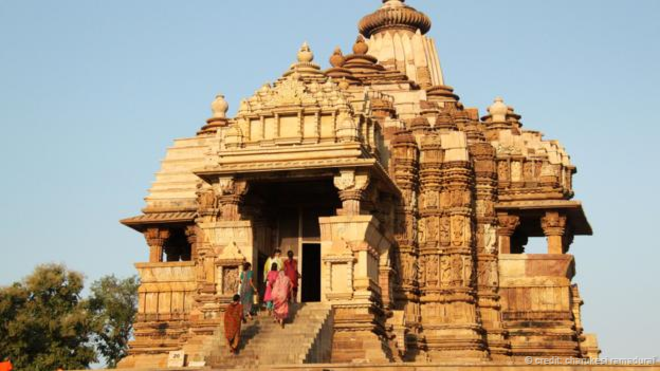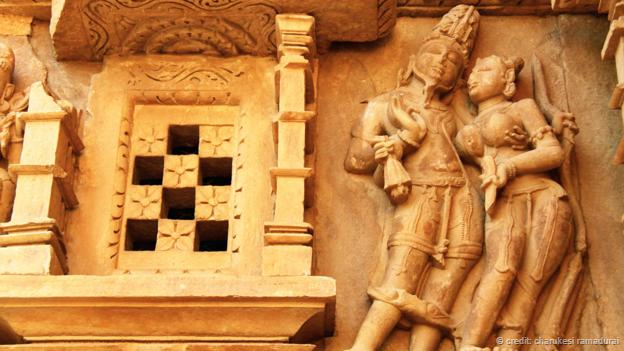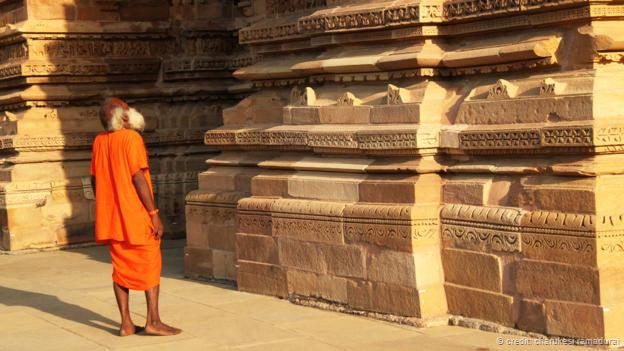印度性庙带来的视觉震撼
BBC查鲁克斯·拉马多莱(Charukesi Ramadurai)(2023年10月19日)

在印度中央邦(Madhya Pradesh)的克久拉霍(Khajuraho),原来有85座寺庙,现在仅存20座。(图片来源:Charukesi Ramadurai)
2013年12月,印度最高法院裁定同性恋为犯罪行为,给印度的男女同性恋、双性恋和跨性别群体带来严重打击。最近,2023年8月,印度政府颁布一项禁令,宣布封禁800多家涉黄网站,以遏制儿童色情和性暴力, 不过该禁令在数日后有条件地取消了。
在过去的数百年里,印度都是一个非常保守的国家,这是受多股清教主义力量作用的结果,其中包括伊斯兰王国、英国的殖民统治以及印度自己的婆罗门教的等级制度。但是印度不是从来如此。
13世纪以前,印度的性规范要远比现在宽松,在尘世和精神世界上都给性以同等重要性。性曾经是正规教育的一门课程。公元前4世纪至公元2世纪之间,印度还为世界贡献了首部性爱专著,《爱经》(Kamasutra)。
事实上,如果你仔细观察,印度随处都可以看到自由开放时代留下的痕迹。在印度奥里萨邦(Orissa)东部的科纳尔克(Konark),建于13世纪的太阳庙的矮石墙上刻有性爱主题的浮雕。而在马哈拉施特拉邦(Maharashtra)有两座佛教石洞,建于公元前2世纪的阿旃陀石窟(Ajanta)和建于公元5世纪至10世纪之间的埃洛拉石窟(Ellora),里面有裸体仙女的壁画和雕塑。

性雕塑(图片来源:Charukesi Ramadurai)
印度画面感最强的性庙艺术作品
然而,保存最完好的、最具画面感的性庙艺术作品位于印度中部中央邦的小镇克久拉霍。这里的印度寺庙因精美的雕塑于1986年被联合国教科文组织列入世界文化遗产目录。这些寺庙建于公元950年至1050年的昌德拉王朝(Chandela dynasty)期间。原来有85座寺庙,现在仅存20座。
冬日的一个午后,我进入了这个占地6平方公里的遗址,沙石闪耀着金光。当地的妇女带着鲜花和佛香来参拜,而参观者则漫步于外层的通道,惊叹于墙上布满的大量复杂的雕像。其中有男神、女神、武士、音乐家、动物和鸟类。这样的景象本可以在印度的任何一座寺庙看到。
但是如果靠近观察,你会发现很多雕像都带有浓重的情色色彩,展示男性、女性,和动物。有三人性爱的场景,也有纵欲狂欢的聚会,还有同性恋和兽交。

一位女士向寺庙参拜(图片来源:Charukesi Ramadurai)
虽然我已经对此有所预期,但是当我清晰地看到雕塑中身材曼妙的少女和精壮的男子以几乎不可能的性交体位交缠在一起,而旁边就是一些对着信徒幸福微笑着的神灵的雕塑,还是感到十分震惊。
虽然一些石块有所破损,一些肢体残缺不全,但是考虑到这些寺庙已经有1000多年的历史,这些雕塑的保存状态是极其完好的。
关于这种对性爱主题的生动描绘有几种说法。一种异域色彩较重的说法是昌德拉王朝的君主信奉主张男女平衡的密宗(Tantric),所以他们建的寺庙也会推崇这一信仰。
其他的解释与那个时代寺庙本身的功能有关:寺庙在当时不仅是崇拜的地方,也是学习的地方——尤其是工艺造型艺术,包括性爱在内。此外,一些人认为对性爱活动的描绘是一种很好的征兆,因为它代表着孕育新生命和新的开始。

雕塑覆盖了外墙的每个角落(图片来源:Charukesi Ramadurai)
除此之外,印度教在传统上就将性视为生活的重要组成部分,这就解释了为什么这类雕塑被随意地夹杂在其他各类活动的雕塑中,比如祈祷和战争。这些雕塑被摆在显眼的位置,而不是被藏到某个不起眼的角落,这就表明了他们的创作者希望大家都能看到它们。
因为与世隔绝,这些生动的雕塑被保存了下来。
奇怪的是,没有人知道为什么这些华丽的寺庙要建在克久拉霍,因为没有清晰的记录表明这里曾经有过王国。这些生动的雕塑之所以能够保存下来,可能要归功于该地区曾经十分茂密的森林在数百年间让这里与世隔绝,直到1838年英国人布特(TS Burt)再次发现这个地方。

一位参观者在雕塑前驻足欣赏(图片来源:Charukesi Ramadurai)
事实上,布特自己也是在他的印度侍从的劝说之下才进行这次旅行;他并不相信这么遥远的地方会有什么有趣的发现。这些充满魅力的寺庙也逃过了印度道德警察的怒火。近年来,他们封禁、毁坏了很多文化艺术品,包括萨尔曼·鲁西迪(Salman Rushdie)的作品和侯赛因(MF Hussain)的绘画。
但是,我觉得比这些露骨的雕塑和它背后的历史更有趣的是,当导游在绘声绘色的讲解位于壮观的肯达利亚·玛哈戴瓦神庙(Kandariya Mahadeva)墙壁高处的更具冲击力的雕塑时,整个一家人都听得全神贯注。
没有人扬起眉毛,也没有人交换尴尬的表情,年轻人也没有露出一丝怪笑。可能,当艺术置身于宗教的背景时,它就是无可厚非的——但是当我离开时,我觉得克久拉霍的墙壁里面藏着的是印度对宽容的一种教诲。
(责编:友义)
India’s temples of sex
By Charukesi Ramadurai
In December 2013, India’s LGBT community suffered a severe setback as the country’s Supreme Court ruled homosexuality to be a criminal offence. More recently, in August 2015, the Indian government imposed a ban, lifted conditionally a few days later, on more than 800 websites deemed pornographic, in an ostensible bid to curb child pornography and sexual violence.
But India was not always like this. Sexual norms were far more liberal before the 13th Century.
India has been a particularly conservative country for the last few hundred years, influenced by the puritanism of several groups, including Islamic dynasties, British overlords and the country’s own Brahmin priestly caste. But India was not always like this. Sexual norms were far more liberal before the 13th Century, giving equal importance to the secular and the spiritual. Sex was taught as a subject in formal education, and Kamasutra, the world’s first sex treatise, was written in ancient India between the 4th Century BCE and the 2nd Century.
In fact, if you look closely, reminders of these more liberal times can be seen across the country. They’re literally carved in stone in the form of erotic motifs on the lower walls of the 13th Century Sun Temple at Konark in the east Indian state of Orissa. Nudity is prominent in the paintings and sculptures of heavenly maidens at Maharashtra’s Buddhist rock-cut monastic caves, Ajanta (2nd Century BCE) and Ellora (5th to 10th Centuries).
India's most graphic example of erotic temple art
However, the best-preserved and most graphic example of erotic temple art can be found in the small town of Khajuraho in the central Indian state of Madhya Pradesh. Its elegantly carved Hindu temples were declared a Unesco World Heritage site in 1986. Built by the Chandela dynasty between 950 and 1050, only 22 of the 85 original temples remain.
When I entered the 6sqkm site late one winter afternoon, the sandstone glowed a burnished gold. Local women carried fresh flowers and incense sticks for their prayers, while visitors perambulated the outer corridors, gawking at the profuse and intricate sculptures that covered every inch of the walls. There were images of gods and goddesses, warriors and musicians, animals and birds. It could have been a scene from any temple in India.
Many of these carvings were of an intensely erotic nature, featuring men, women and animals.
But on closer inspection, many of these carvings were of an intensely erotic nature, featuring men, women and animals. There were depictions of threesomes, orgies and bestiality. Although I knew what to expect, I was still taken aback by shapely maidens and virile men contorting their bodies in impossible sexual positions, right next to sculptures of divine beings smiling blissfully at the devout. Although a few stones were chipped and several limbs broken, the carvings were incredibly pristine, considering that the temples are more than 1,000 years old.
There are various theories about the existence of such graphic erotic motifs. One of the more exotic ones propounds that since Chandela kings were followers of Tantric principles, which dictate the balance between the male and female forces, they promoted their faith in the temples they created.
Some believe the depiction of sexual activities was considered a good omen.
Other theories have to do with the role of temples themselves in those times: they were considered places of learning as well as worship – especially of the finer arts, including the art of lovemaking. In addition, some believe that the depiction of sexual activities in temples was considered a good omen because it represented new beginnings and new life.
That apart, Hinduism has traditionally considered sex an essential part of life, which could be why the carvings are casually interspersed between others that portray activities as varied as prayer and war. The fact that they are set in plain view and not tucked away in an obscure corner seems to suggest that their creators meant for them to be seen by all.
Isolation helped these graphic motifs survive
Bizarrely, there’s no reason why these ornate temples were built at Khajuraho, since there’s no clear record of whether there was even a kingdom in this location. The survival of these graphic motifs can likely be attributed to their isolation for hundreds of years in the region’s once-thick forest, only rediscovered by Englishman Captain TS Burt in 1838. In fact, Burt himself had to be persuaded by his Indian attendants to make the journey; he didn’t believe anything of interest would be found at the remote spot. These charmed temples have also managed to evade the wrath of India’s moral police, who in recent years banned or destroyed a range of cultural artefacts, ranging from Salman Rushdie’s books to MF Hussain’s paintings.
But what I found even more interesting than the explicit carvings and the history behind them was the fact that entire families were quietly engrossed in the guide’s speech as he analysed the spicier carvings high on the walls of the magnificent Kandariya Mahadeva temple. No eyebrows were raised, no embarrassed looks were exchanged, no giggles escaped young lips. Perhaps the art is unobjectionable when crouched within a religious context – but I came away believing that Khajuraho holds within its walls a larger lesson on tolerance for India.